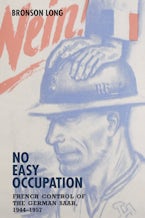
Title Details
268 Pages
22.8 x 15.2 cm
2 line illus.
Series: German History in Context
Series Vol. Number:
3
Imprint: Camden House
No Easy Occupation
French Control of the German Saar, 1944-1957
- Description
- Contents
- Reviews
The first up-to-date study in English of the Saar dispute, an important stage in French-German postwar relations and thus significant for European integration.
After 1945, France and West Germany were involved in a bitter dispute over the Saar, a small, coal-rich, culturally German territory bordering France's Lorraine region that France had occupied at war's end. French officials and the Saar's political elite attempted to wrest the territory from Germany and make it an independent nation oriented culturally towards France. Although France's occupation officially ended in 1947 with the ratification of a new constitution and elections, the new Saar state was not fully sovereign, as French control persisted until 1955. The Saar's status was an increasing concern for West Germany, partly due to its implications for the division of Germany.After lengthy negotiations, France and West Germany agreed to turn the Saar into a European territory and the seat of European institutions, much as today's Brussels. Saarlanders, however, saw this as a French ploy to maintain control, and in a heated 1955 referendum voted against it, leading to the territory's reunification with West Germany. This is the first study in English dealing with the German research of recent decades and citing original French and German sources.
Bronson Long is Associate Professor of History at Georgia Highlands College.
After 1945, France and West Germany were involved in a bitter dispute over the Saar, a small, coal-rich, culturally German territory bordering France's Lorraine region that France had occupied at war's end. French officials and the Saar's political elite attempted to wrest the territory from Germany and make it an independent nation oriented culturally towards France. Although France's occupation officially ended in 1947 with the ratification of a new constitution and elections, the new Saar state was not fully sovereign, as French control persisted until 1955. The Saar's status was an increasing concern for West Germany, partly due to its implications for the division of Germany.After lengthy negotiations, France and West Germany agreed to turn the Saar into a European territory and the seat of European institutions, much as today's Brussels. Saarlanders, however, saw this as a French ploy to maintain control, and in a heated 1955 referendum voted against it, leading to the territory's reunification with West Germany. This is the first study in English dealing with the German research of recent decades and citing original French and German sources.
Bronson Long is Associate Professor of History at Georgia Highlands College.
Introduction
France Acquires the Saar
Nazi Ghosts and Military Rule
De-Prussianizing the Culture
Marianne Gives Birth to an Autonomous Saar
Breaking and Remaking Cultural Bonds
West Germany Enters the Fray
Cultural Quagmire
"Europe's District of Columbia"
The Climatic Referendum
Conclusion
Bibliography
Index
France Acquires the Saar
Nazi Ghosts and Military Rule
De-Prussianizing the Culture
Marianne Gives Birth to an Autonomous Saar
Breaking and Remaking Cultural Bonds
West Germany Enters the Fray
Cultural Quagmire
"Europe's District of Columbia"
The Climatic Referendum
Conclusion
Bibliography
Index
"Long's work stimulates very interesting discussions. His concisely written book provides information about many areas during these post-war years on the Saar, which were so exciting precisely because local, regional, bi-national, and international levels were always closely intertwined." Rainer Hudemann, GERMAN HISTORICAL INSTITUTE LONDON BULLETIN
"Long has written a fascinating book about a topic that has long been neglected in English-speaking historiography. He bases it on an impressively large body of primary sources from archives, newspapers, and posters. His concise study vividly portrays an important chapter of German, French, and European history. HISTORISCHE ZEITSCHRIFT" HISTORISCHE ZEITSCHRIFT
"[V]aluable. . . provides an up-to-date treatment, in English, of the Saar dispute. Employing a thematic approach to the topic, [Long] relies on both French and German primary sources, and he adjuticates between previous scholarly interpretations of this affair." JOURNAL OF MODERN HISTORY
"[Long] evoke[s] the reader's interest in this little territory in the southwest of Germany as he describes the complexity of its history. The story of the Saarland between 1944 and 1957 thus contributes to the history of borderlands, French colonialism, German state building, and nationalism, as well as to the history of Europeanization in the wake of World War II." H-NET GERMAN
"Bronson Long's in-depth study of French policy in the Saar between 1944 and 1957 is to be thoroughly welcomed. . . . What Long has achieved . . . is . . . the first systematic and sophisticated study on the Saar question in English, which one can only hope will make the subject accessible to a wider group of scholars interested in instances of foreign rule, Franco-German relations, and postwar European history more broadly." GERMAN HISTORY
Hardcover
9781571139153
October 2015
$115.00 / £97.00
Ebook (EPDF)
9781782045618
October 2015
$29.95 / £24.99
Title Details
268 Pages
2.28 x 1.52 cm
2 line illus.
Series: German History in Context
Series Vol. Number:
3
Imprint: Camden House












